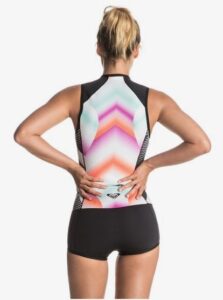Wetsuits are a must-have for any water sports enthusiast. They keep the body warm in cold water, provide buoyancy, and protect the skin from the harsh sun and elements. There are many types of wetsuits available in the market, each designed for a specific purpose. In this blog post, we will explore the different types of wetsuits and their uses.
Full Wetsuits:
 Full wetsuits are the most common type of wetsuits. They cover the entire body, from the neck down to the ankles. These wetsuits are made of neoprene, a type of synthetic rubber that is resistant to water, heat, and chemicals. Full wetsuits come in different thicknesses, ranging from 2mm to 6mm, depending on the water temperature. The thicker the wetsuit, the warmer it is.
Full wetsuits are the most common type of wetsuits. They cover the entire body, from the neck down to the ankles. These wetsuits are made of neoprene, a type of synthetic rubber that is resistant to water, heat, and chemicals. Full wetsuits come in different thicknesses, ranging from 2mm to 6mm, depending on the water temperature. The thicker the wetsuit, the warmer it is.
Spring Suits:
Spring suits, also known as shorty wetsuits, are designed for warmer water temperatures. They cover the torso and arms, leaving the legs exposed. Spring suits are made of thinner neoprene, typically 2mm to 3mm thick. They provide enough warmth for comfortable swimming and surfing in mild water temperatures.
Long John Wetsuits:
Long John wetsuits are sleeveless wetsuits that cover the torso and legs. They are popular with surfers and paddleboarders who want maximum mobility in their arms. Long John wetsuits are made of thin neoprene, typically 2mm to 3mm thick, and are ideal for warmer water temperatures.
Short John Wetsuits:
 Short John wetsuits are similar to Long John wetsuits, but they do not cover the legs. They are ideal for warmer water temperatures and are popular with swimmers and surfers who want maximum mobility in their arms. Short John wetsuits are made of thin neoprene, typically 2mm to 3mm thick.
Short John wetsuits are similar to Long John wetsuits, but they do not cover the legs. They are ideal for warmer water temperatures and are popular with swimmers and surfers who want maximum mobility in their arms. Short John wetsuits are made of thin neoprene, typically 2mm to 3mm thick.
Rash Guards:
Rash guards are not technically wetsuits, but they are designed to be worn in the water. They are made of stretchy, quick-drying material that is comfortable to wear and provides UV protection. Rash guards are ideal for water sports that involve a lot of paddling, such as surfing and kayaking. They can be worn alone or underneath a wetsuit for added warmth.
Dry Suits:
Dry suits are designed for extremely cold water temperatures. They are made of waterproof, breathable material that keeps the body completely dry. Dry suits come with waterproof zippers and seals around the wrists, ankles, and neck to prevent water from entering. Dry suits are typically worn by scuba divers, who need protection from the cold water and want to stay dry during their dive.
Wetsuits come in different types and thicknesses to suit different water temperatures and water sports. Whether you are a surfer, paddleboarder, swimmer, or scuba diver, there is a wetsuit that is perfect for you. Choose the right wetsuit for your activity and water temperature to ensure that you stay warm and comfortable in the water.
